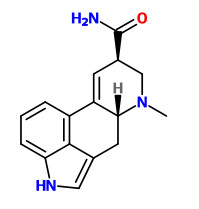Argyreia nervosa (Burm.) Bojer - syn.Argyreia speciosa (L. f.) Sweet; Convolvulus nervosus Burm. f. (basionym); Convolvulus speciosus L. f.; Lettsomia nervosa (Burm. f.) Roxb.; Rivea nervosa (Burm. f.) Hall. f. - Convolvulaceae
Hawaiian baby wood rose, silver morning glory, Hawaiianische Holzrose, Silberwinde
Perennial climber, native to India, Ceylon, naturalized in Hawaii, cultivated elsewhere; tender young stems covered with silky hair, more mature stems woody; leaves cordate, thickly veined on the under surface, mature ones ranging from 12-22cm in length, top surface smooth, green; petioles of round, tapering, shorter than the leaves; long-stalked clusters of pink flowers, funnel-shaped, 5-9cm long, smooth and shiny inside, white flocks outside; smooth and pointed brown seed capsules surrounded by five sepals; stalked sepals with capsules used in winter floral arrangements. [Identification notes on the tropical wood rose. McJunkins, S. P., Thornton, J. I., Dillon, D. J., Journal of the Forensic Science Society, Vol.8(2), 1968, 121-124]
„Seeds dark to light brown, glabrous… The leaves are used as poultices for wounds and for skin diseases.“
http://www.efloras.org/florataxon.aspx?flora_id=5&taxon_id=200018779
„Chemical analysis showed that the seeds of Argyreia nervosa contain the highest percentage of indole alkaloid constituents (0.5-0.9%) of the genera of the Convolvulaceae thus far studied. A total of 19 indole alkaloids were identified by thin-layer and paper chromatographic procedures. Of these, lysergene, festu-clavine, setoclavine, isosetoclavine, agroclavine, elymoclavine, ergine, and isoergine were isolated by column chromatographic procedures and characterized by TLC and IR analyses. Penni-clavine, chanoclavine-I, chanoclavine-II, ergometrine, ergometrinine, lysergic acid α-hydroxyethylamide, isolysergol, racemic chanoclavine-II, molliclavine, lysergol, and isolysergic acid α-hydroxyethylamide were identified by TLC only. Of these, lysergene, setoclavine, isosetoclavine, chanoclavine-II, racemic chano-clavine-II, isolysergol, and molliclavine were identified for the first time in species of the Convolvulaceae. Ergine (0.136%) and isoergine (0.188%) were found in the highest concentration. In addition, 11 unidentified indole alkaloids were detected, these being found in very low concentration. Although the pericarp showed the same alkaloid pattern as the seeds, the concentration was much lower (0.0015%). No alkaloids could be delected in the vegetative tissues of nonflowering specimens.“
[Ergoline alkaloidal constituents of Hawaiian baby wood rose, Argyreia nervosa (Burm. f.) Bojer., Chao, J. M., Der Marderosian, A. H., Journal of pharmaceutical sciences, Vol.62(4), 1973, 588-591]
 ergine (lysergic acid amide, LSA)
ergine (lysergic acid amide, LSA)
„The seeds of the Hawaiian baby woodrose (Argyreia nervosa) are used by adolescents as a supposed hallucinogenic drug. These seeds are legally available and broadly sold. The active components are alkaloids structurally related to lysergic acid diethylamide (LSD). However, the psychic effects are very different from those of LSD and are dominated by rather sedative, uncomfortable autonomic disturbances similar to the effects of scopolamine. The (psycho)pharmacological profile is described on the basis of the active substances lysergacidamide and lysergacidethylamide (and their isomers). It is shown that neither the substances themselves nor the mixture are able to evoke LSD-like perceptual variances. The exposure of Argyreia nervosa is described focusing on potential fetal distress by contained ergometrine and the case history of an intoxication.“
[Hawaiianische Holzrose:(Psycho-) Pharmakologische Wirkungen der Samen der Argyreia nervosa Eine fallbezogene Darstellung. Borsutzky, M., Passie, T., Paetzold, W., Emrich, H. M., Schneider, U., Der Nervenarzt, Vol.73(9), 2002, 892-896]

Argyreia nervosa (Burm.f.) Bojer as Convolvulus speciosus L.f., Smith, J.E., Icones pictae plantarum rariorum, t.17 (1790)
http://plantgenera.org/species.php?id_species=85029